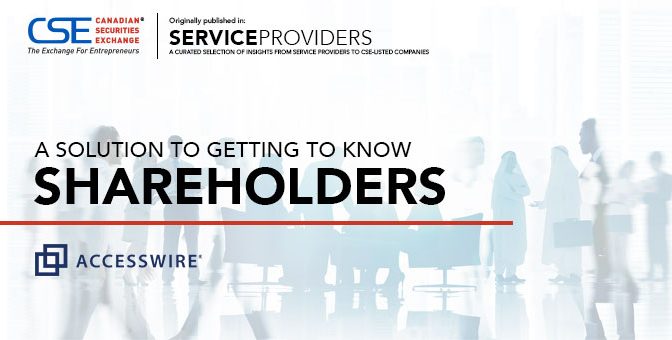Reality Check: How Well Do You Know Your Shareholders?
No, really — how well?
Most public companies suffer from a lack of information that is typically found in small private companies. Small private companies experience the support of friends and family, small family offices or even venture capital firms that speculate on their behalf. Actually, public companies don’t operate much differently. They, too, experience the support of friends, family and seed investors. The difference is that one day the IPO lures a company in to go public.
The “Problem” with Going Public
It begins when bankers, institutions and small funds lead the way in offering your company to go public. Some stay for a while and some are small gain-focused funds or institutions that are out on day one, making their money on the run up of the IPO. The end result: You’re left with hundreds, if not thousands, of shareholders. You have no clue who they are, what they represent, what their expectations are and, again, who they are.
I call them “boosters.” Boosters are a group of very intelligent, well-connected individuals that operate under the acronym “IRO” as a consultant and/or firm and want to help your company find new shareholders. It’s their job to make introductions to people in their networks. If you do well in presenting your story and delivering and your guidance is on target, you will find shareholders. Rinse and repeat with non-deal-road-show investor conferences and inbound interest. Before you know it, you’ve gone from 25 friends and family investors and one local fund in your network to more than 3,000 shareholders, some of which own up to 10 percent of the company. Then it hits you: You don’t know who these people are, who knows whom and if this even affects your company.
The Solution: Shareholder ID
It’s absolutely essential to the success of your public company that once a year you conduct a sound shareholder identification analysis. If you have sustained volume and people coming in and out of the story and people accumulating more and more, then you should consider hiring a firm to help manage this for each quarter. First, a robust Shareholder ID program will identify street positons in variant forms, objecting beneficial holders (OBO) and non-objecting beneficial holders (NOBO). Then, the program will identify the registered positions analysis to see if firms and individuals show up on both lists. A robust Shareholder ID program will not only highlight the brokers and banks that hold ownership, but also the underlying shareholder(s), and if that shareholder is party to another firm or group who also owns shares in your company. This is where activists come in; this is where share voting is greatly improved; and this is where real relationships are formed.
Every shareholder has a price horizon; it’s important you know this, for many reasons. One, you should understand how much time you invest in getting to know them, what else they invest in, whom they know, where they went to school and what they model your business out to be. The more you get to know your shareholder, the more you will understand these things. The more you understand these things, the quicker you can step up the shareholder base.
The more you get to know your shareholder, the more you will understand these things.
The more you understand these things, the quicker you can step up the shareholder base.
I’m a realist, and I enter a relationship with a shareholder knowing that if she/he makes a decision to purchase some shares in my company in the open market, most likely she/he will be my friend for a short period of time. This works. I don’t want a marriage — I have one. What I do want is to make them money, plain and simple. And I do that by executing my strategy, communicating my message and delivering. No disrespect intended when I say to any shareholder, either individual or firm/institution, that I want to sell when they’re ready and move on to the next one, to build a relationship with a new one, and repeat this process again. Every now and then, however, you find fans, regardless if they are high net worth people or firms, that love your business, your industry and you. They become the glue of your shareholder base, and they are rare. You might not even know who they really are. Do you want your company’s biggest fans to be a stranger to you and your management team? I think not!
Do you want your company’s biggest fans to be a stranger to you and your management team?
Over the past 10 years, I have met hundreds of CEOs that don’t know their shareholders, don’t understand the mechanics of their shareholder base, and refuse to invest the time or resources in learning it. By contrast, I have met a very small percentage of C-level executives who get this simple exercise and have the best shareholder bases I have ever seen.
Ask your IRO, your outsourced IR firm or even your transfer or annual meeting management company for help. If they can’t do this for you, they should refer you to a trusted company that can.
This story was written by ACCESSWIRE and featured in Service Providers magazine.

